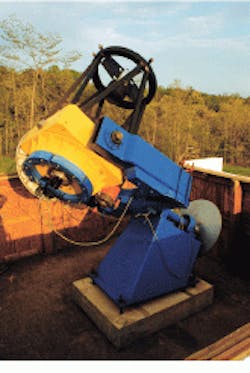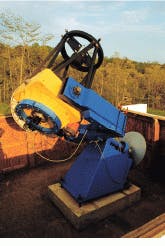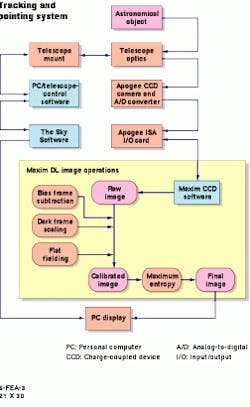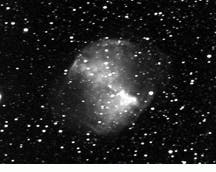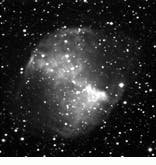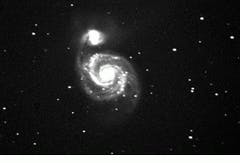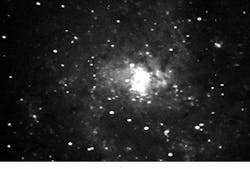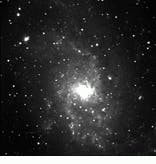Off-the-shelf software provides astronomy researchers provides with deblurred images
Off-the-shelf software provides astronomy researchers provides with deblurred images
PC-based astronomical telescope derives real-time, color-processed, filtered, enhanced star-type images with a custom CCD camera and special software.
By Lawrence J. Curran, Contributing Editor
tars in the night sky appear as pinpoints to the human eye, but the telescope-linked cameras used by astronomers often "see" their targets more like blobs or blurred images than as sharply defined point sources of light. This blurring complicates the process of obtaining precise astronomical images and necessitates extensive modification of the captured images by software techniques.
One successful software method for deblurring images uses deconvolution techniques, and one of its popular implementations is the maximum-entropy method (MEM). Also called maximum-entropy deconvolution or maximum-entropy restoration, the MEM concept is based on a powerful algorithm that has its roots in radio astronomy. It was recently applied to compensate for optical defects in the Hubble Space Telescope. These defects caused the telescope to deliver blurred images, but MEM software salvaged the images by applying deblurring techniques.
The Puckett Observatory (Ellijay, GA) is reporting impressive deblurring results using a Ritchey-Chretien-type telescope driven by a Pentium-based personal computer (see Fig. 1), a charge-coupled-device (CCD) camera, and MEM software from Cyanogen Productions Inc. (Nepean, Ont., Canada) called MaxIm DL and MaxIm CCD (see "Maximum entropy teams with CCDs to image stars," p. 44). MaxIm DL software has a variety of image-processing and enhancement tools, including flexible-kernel and fast-Fourier-transform (FFT) filtering, unsharp mask, nonlinear and histogram-based stretching, and color processing. MaxIm CCD software is an optional add-on package for MaxIm DL that can directly control CCD cameras.
Tim Puckett, an amateur astronomer who owns and operates the observatory, says he has used MEM software to remotely control and error-map telescope functions and has greatly increased the amount of data obtainable during a single evening session. His software-based system includes MaxIm DL, MaxIm CCD, The Sky graphical interface/database software from Software Bisque (Golden, CO), and telescope-control software (TCS) from Comsoft Inc. (Tucson, AZ; see Fig. 2).
Doug George, a partner and engineer at Cyanogen Productions, says the chief limiting factor for ground-based telescopes, and a major contributor to blurring, is atmospheric turbulence. Because air pockets with different temperatures possess different refractive indices, different temperatures result in air motion. "This motion causes a continual shifting of cells of different refractive-index air within the light column between the star or another target and the telescope," explains George. The resulting effects of varying refraction cause image wander and optical distortion.
Large ground-based telescopes are sometimes limited by the quality of their optics, especially older instruments. Problems are caused by "dome seeing," which results from hot air flowing out the slit in the telescope mount. Blur can also be caused by tracking inaccuracies or wind loading that jostles the image.
"But all these problems can be controlled by proper engineering," says George. "This includes careful interferometric testing during polishing, dome refrigeration, and tip/tilt fast guider installation. None of these solves the problem of atmospheric `seeing` or turbulence, however," he adds.
Some experimental adaptive-optic systems can compensate for atmospheric turbulence, "but these are complicated and re stricted in application, and they only work within a small radius of a bright object," says George. Deconvolution techniques, such as MEM, are often the only practical method of telescope image-resolution enhancement.
PCs prove useful
Years ago, MEM programs were run on large, expensive mainframe computers because the imaging techniques were mathematically complicated and required the use of high-speed processors and substantial main memory. With the advent of powerful personal computers (PCs), however, astronomers found they could run MEM on PCs with excellent imaging results (see Fig. 3). The PC used can be just about any Pentium-based Windows 95 or Windows NT machine, according to George.
He says a number of deconvolution techniques are available, but most fail when used for astronomical images because of limited signal-to-noise ratio. "Deconvolution is a division operation in the frequency domain, so it results in noise amplification. Iterative techniques, such as MEM, include algorithmic features that control noise amplification," George says (see "Understanding maximum-entropy deconvolution," p. 48).
Deblurring with maximum entropy suits CCD cameras because they deliver a digital output that is easily computer processed, George notes. But small size limits the use of CCDs to recording only small areas of the sky when these cameras are applied with the focal lengths needed to capture high-angular resolutions. The resolution of small CCDs is also compromised by blurring influences.
In contrast, MEM can sharpen image resolution by as much as a factor of two or three. George says this degree of improvement means that, with a cooled CCD and maximum entropy, a 16-in. telescope can deliver the resolution and accuracy associated with a 50-in. photographic telescope.
Deconvolution details
George points out that the image of a star appears as a blob--a shape known as the star`s point-spread function (PSF). "This phenomenon applies to extended objects, such as planets and galaxies, as well," George says. "In fact, each point of an image is said to be convolved with the PSF. Deconvolving the PSF removes some of the blur and yields a sharper, more detailed image of the objects of interest," he adds.
A simple approach to deconvolution is to apply a Fourier transform to the image. This process changes the image from an array of numbers representing light intensity to an array representing spatial frequencies that correspond to the features within the image. This array is then divided by the Fourier transform of the PSF. Next, an inverse Fourier transform is performed on the result that produces a sharper image. A modification of this process, called a Weiner filter, removes the effects of zeros in the PSF, which would cause a division by zero.
"It sounds simple enough, but deconvolution isn`t simple in practice," contends George. "For one thing, noise is unavoidable in CCDs, and any random noise in an image will create a mess that shows up as all sorts of spurious features in the sharpened image."
The maximum-entropy method solves the noise problem by processing the image iteratively using statistical methods. In each step of the process, the results of the previous iteration are convolved by the PSF and then compared statistically to the original image. A control algorithm is used to produce an output image, which is then fed into the next iteration.
"The processing requires that a number of Fourier transforms must be performed at each iteration," George says. "Most images are fully deconvolved after 15 iterations, and the details that were originally obscured by blurring can then be easily seen," George says.
Cyanogen Productions has built on the core MEM algorithm by adding a set of tools that help determine the proper PSF and other initialization parameters. George points out that, while MaxIm DL software is intricate computationally, it is simple to use. "The program requires information on just three basic parameters: camera sensitivity, background noise level, and point-spread function," he says.
The MaxIm DL software helps determine all three parameters and also offers a utility to determine the gain of the CCD camera. Camera sensitivity can usually be obtained from the manufacturer`s specifications. Based on statistical methods, MaxIm DL calculates the number of detected photons that will produce a pixel value. For example, if 160 photons produce a count of 10, then the camera gain is 16 photons. This gain is equal to 1 ADU (analog-to-digital unit) or 16 photons per ADU. The MEM algorithm is then used to multiply the count of 10 by 16 to obtain 160, which is the measured number of photons.
George says that the MEM needs to work with photon data so that it can correctly interpret the statistics. "Specifically, it assumes that light follows a Poisson distribution, so the variance equals the mean. It uses the brightness in each pixel as a measure of how much noise is present in that pixel.
"Further, knowing the value of the background noise level allows MaxIm DL to extract details rather than attempting to deconvolve the noise," declares George. "But an accurate estimate of the PSF is important for the program to work effectively, and that`s usually determined directly from a star image within a CCD frame," he notes.
The MaxIm DL software also includes a tool to extract a suitable star image automatically. This tool is either used directly as a PSF or it is used to fit a mathematical distribution of the image, which is then used as the PSF. After all the data are loaded into the system, the deblurred image will take shape on the computer monitor. George says a 233-MHz Pentium-based system running Windows 95 can perform a 512 ¥ 512-pixel, 15-iterative deconvolution in 108 seconds, or approximately seven seconds per iteration. The same deconvolution on a 256 ¥ 256-pixel image requires 28 seconds or almost two seconds per iteration.
The MaxIm CCD software acquires the image, and then the MaxIm DL software automatically performs several calibration steps on the image, such as bias frame subtraction, dark frame scaling and subtraction, and flat-fielding. All the data are stored on a disk with appropriate header information. The image can then be processed either at a later time or during a successive exposure.
Error compensation
"All telescopes have intrinsic pointing errors," Puckett emphasizes, "but these errors can be mapped into a computer for error compensation. The program we use for compensation from TPoint Software (Abingdon, England) was designed by Patrick Wallace in the United Kingdom. It achieves a pointing accuracy of 15 seconds of arc rms, which is very good for most telescopes," he contends.
Another software package, The Sky program from Software Bisque (Golden, CO), provides a graphical interface that can display several hundred thousand objects from its database. Puckett describes this software as "a powerful astronomical planetarium program that will accurately depict the night sky at any time from anywhere. Simply clicking on any star or deep-sky object present in the database results in a wealth of information shown of that object."
The Sky program can also control telescopes--in this case using an RS-232 cable connection--and make them point more precisely by "learning" about their mechanical deficiencies," adds Puckett. When his telescope arrives at the desired position, the MaxIm CCD software issues operational instructions to the Apogee Instruments` AP7 CCD camera using a proprietary ISA-bus camera-controller card. The camera head communicates to the card via a single high-speed 37-pin cable. Power for the camera head comes from the PC backplane. The MaxIm CCD software reads the image from the card and displays the image on the PC monitor. Image download from the camera head to the display requires 11 seconds.
System choices
Puckett chose the Cyanogen software products "because the cost was reasonable, and the software developers were receptive to making changes and refinements for our needs. The MaxIm software allows the fastest image calibration I`ve used," he reports. He selected the AP7 CCD camera because "its performance was better than the other products tested--even products that were double the price."
FIGURE 1. Designed and built by Tim Puckett, the Puckett Observatory is located on a mountain in north-central Georgia. It uses a 60-cm Ritchey-Chretien-type telescope that has a focal ratio of f/8. The telescope works in conjunction with a 16-bit CCD camera system, a 512 ¥ 512-pixel back-illuminated CCD, and several software packages that control system operation and image acquisition and enhancement.
FIGURE 2. To obtain deblurred images of astronomical targets, the Puckett Observatory in Georgia has developed a Pentium-based computer system that uses maximum-entropy (MEM) software. This MEM software includes a variety of color-image-modification, processing, enhancement; flexible-kernel and fast-Fourier-transform filtering; and telescope control tools.
FIGURE 3. Three pairs of images taken at the Puckett Observatory demonstrate the effectiveness of applying deblurring techniques to obtain improved images using maximum entropy restoration.
Maximum entropy teams with CCDs to image stars
The Puckett Observatory is situated on a mountain in north-central Georgia. It uses a 60-cm Ritchey-Chretien-type reflecting telescope with a focal ratio of f/8. Tim Puckett has designed and built the telescope over a 10-year period. The telescope is used in conjunction with an AP7 16-bit CCD camera system from Apogee Instruments Inc. (Tucson, AZ). The camera contains a 512 ¥ 512 back-illuminated CCD manufactured by Scientific Imaging Technologies Inc. (Beaverton, OR).
The telescope is computer-controlled and can be operated from a remote location. Puckett assembled the board-level computer, as well, which contains a 166-MHz Pentium processor. The software that controls the telescope is from Comsoft Inc. (Tucson, AZ). This software is linked to The Sky program from Software Bisque (Golden, CO).
Puckett uses Cyanogen`s MaxIm DL software primarily for the image acquisition and enhancement of asteroids and comets and to obtain precise positional and magnitude estimates. "It helps refine the orbit solution for these objects," he says.
Puckett combines many images of the same object to obtain a better signal-to-noise ratio and to remove unwanted signals caused by cosmic ray hits. "The software system allows me to automatically calibrate each image by automatically subtracting the bias, thermal noise, and flat fields," he reports. "Real-time automatic calibration allows me to examine the images for faint objects as they are acquired, rather than waiting and hoping for the best."
How it works
In operation, the telescope, which consists of high-power optics, stepper motors, gears, and other controller products, can be commanded to slew to a specified target. Once the telescope is positioned, it receives light from a star or an object that strikes the pixels in the CCD camera. The camera is cooled to -55C below ambient temperature by a thermoelectric cooler to reduce unwanted thermally generated signals.
The generated photons are converted to electrons by the CCD subassembly and are then read out as analog signals. The AP7 camera contains a custom-thin CCD, which is backlit. "This design more than doubles the ability of the CCD to convert photons into electrons," Puckett points out. In the red region of the spectrum, the CCD is capable of converting up to 86 out of every 100 photons that strike the CCD. In the blue region of the spectrum, it is seven times more efficient than normal, front-illuminated CCDs, he adds.
In turn, the analog signals are digitized to 16 bits by an analog-to-digital converter in the CCD camera head. Next, the digital signals are sent to an ISA-bus input/output board in the computer.
The MaxIm DL software automatically calibrates the image using previously acquired bias, thermal frame, and flat-field data. The image can be automatically saved so that many images of the same object can be taken in succession. "The image is then free to be enhanced using a variety of image-processing routines, such as histogram equalizations, maximum-entropy deconvolution, image registration and combining, and complex pixel math," says Puckett.
Puckett states that earlier front-side CCD devices "are less efficient in gathering photons and so require much longer integration times. This means I was able to gather much less data. For the affordable cost of the Apogee AP7 back-illuminated, thin CCD, I can triple the amount of data collected compared to that of a front-side illuminated device."
Puckett adds that with the advent of MaxIm DL he is able to do real-time data calibration and inspection instead of spending hours independently calibrating each image. "The whole process is much faster and simpler, and my results are greatly improved, compared with earlier methods, in large part because of the maximum-entropy-method-based MaxIm software. With these products, all the hardware and software elements operate in a multi-tasking Windows environment on Pentium-based PCs. I am therefore able to incorporate all these tasks into one PC," Puckett concludes.
L.C.
Understanding maximum-entropy deconvolution
The term "entropy" in maximum-entropy deconvolution comes from information theory, not from thermodynamics. According to Doug George, partner and engineer at Cyanogen Productions, entropy used here is a measure of how much information is in an image compared to the maximum amount the image can contain.
Blurring of an image spreads the information around so that knowing the value of one pixel also indicates something about the value of its neighboring pixels. But precise information about an individual pixel is therefore diluted, and the task is to maximize the imaging information.
Deconvolution assists in obtaining that information. It is controlled by minimizing the statistical differences between the original and final images and by maximizing the information content. These two constraints help assure that the iterative deconvolution process is converged.
L. C.
